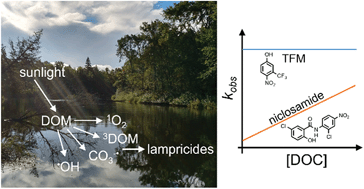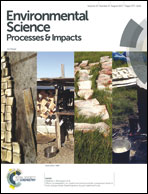Indirect photodegradation of the lampricides TFM and niclosamide†
Abstract
3-Trifluromethyl-4-nitrophenol (TFM) and 2′,5-dichloro-4′-nitrosalicylanilide (niclosamide) are lampricides used in tributaries of the Great Lakes to kill the invasive parasitic sea lamprey (Petromyzon marinus). Although the lampricides have been applied since the late 1950s, their photochemical behavior in natural environments is still not well understood. This study examines the indirect photodegradation of these two compounds and the resulting yields of organic and inorganic photoproducts in water samples collected from five tributaries of Lake Michigan. The tributaries were selected to span the length of Lake Michigan and its natural carbonate geologic gradient. In the presence of dissolved organic matter (DOM), the niclosamide photodegradation rate triples, while the rate of TFM photodegradation is unchanged. Additionally, the yield of lampricide organic products is influenced by DOM because many of the organic photoproducts themselves are prone to DOM-mediated indirect photodegradation. The indirect photodegradation of niclosamide is primarily mediated by reaction with singlet oxygen, which accounts for more than 50% of the increased photodegradation rate. Additionally, hydroxyl radicals and carbonate radicals (CO3−˙) influence niclosamide indirect photolysis, and their contribution is dependent on the specific river water chemistry. For example, CO3−˙ contribution to niclosamide photodegradation, while small, is greater in southern tributaries where there is higher carbonate alkalinity.



 Please wait while we load your content...
Please wait while we load your content...